#DuPont Street
Explore tagged Tumblr posts
Text
angel numbers everywhere

#111#angel numbers#Chinatown#111 Pender Street#DuPont Street#Red light district#Random late night walks
3 notes
·
View notes
Text
Front garden pink peonies and yellow lilies #toronto #dupontstreet #dovercourtvillage #spring #flowers #pink #peony #peonies #yellow #lilies
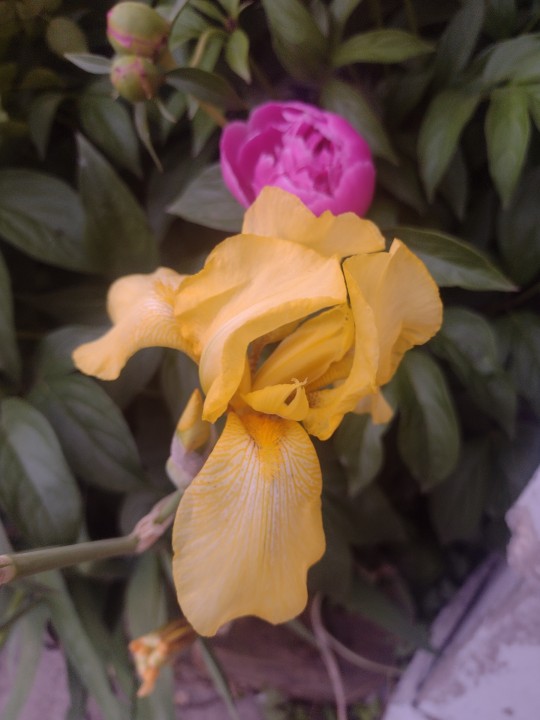
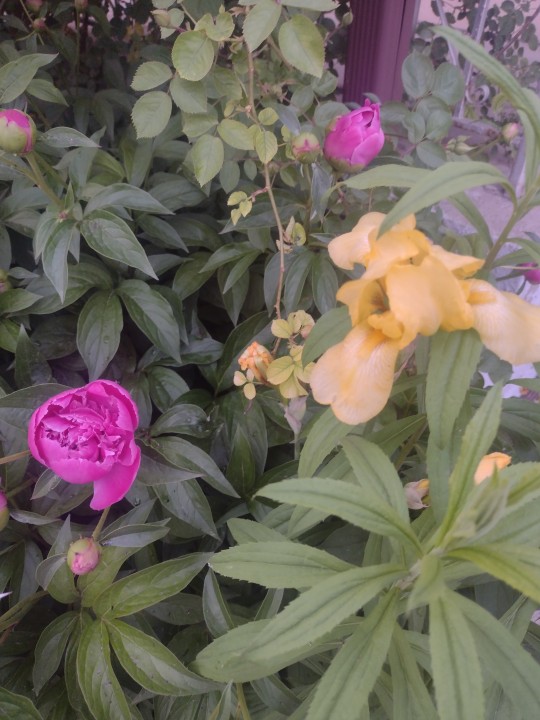
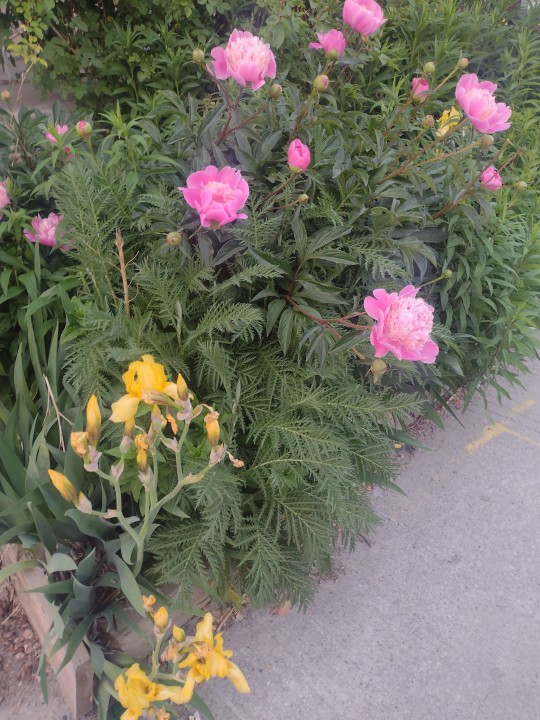
4 notes
·
View notes
Photo

“161 Street Scene In Chinatown” c. 1885. Photograph by A.J. McDonald (from the Marilyn Blaisdell collection and the Oakland Museum of California).
Fatherly Images from Old Chinatown
Fatherhood is a timeless concept that transcends borders and cultures. Within the vibrant tapestry of San Francisco’s Chinatown during the pre-1906 era, the fathers of the community played a vital role in shaping the lives of their children and preserving the rich heritage of their ancestral homeland. Through their dedication, sacrifice, and unwavering commitment, these fathers navigated the often daunting challenges of a hostile, white supremacist polity while preserving their cultural traditions and nurturing a sense of identity within the first of what would be several new native-born generations produced by successive waves of the Chinese American diaspora.

“A Street Scene in Chinatown. San Francisco. Cal.” c. 1890. Stereograph by A.J. McDonald (from the collection of the OMCA).
Life in San Francisco Chinatown during the late 19th and early 20th centuries represented a complex tapestry of adversity and opportunity. The city’s first Chinese Americans faced discrimination, segregation, and the weight of economic privation. Yet, despite these obstacles, at least the photographic record presents the fathers of old Chinatown as beacons of strength and resilience for their families.
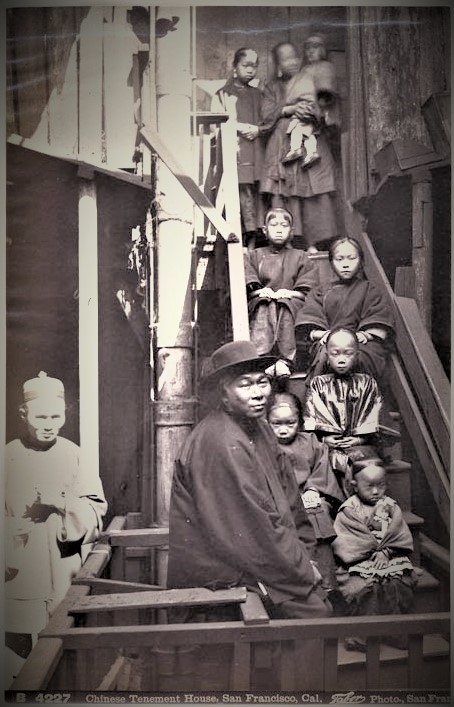
“B 4227 Chinese Tenement house, San Francisco, Cal.” c. 1884. Photograph by Isaiah West Taber (Martin Behrman Negative Collection / Courtesy of the Golden Gate NRA, Park Archives also from the California State Library). A Chinese father (or, as some viewers have more sinisterly implied, a “guardian”) for seven children and mother, posed on stairs leading to second floor entrance. A second man stands to left of the bottom of the stairs.

“B 5404 An Alley in Chinatown, San Francisco, Cal.” c. 1885. Photograph by Isaiah West Taber (from the Marilyn Blaisdell collection).
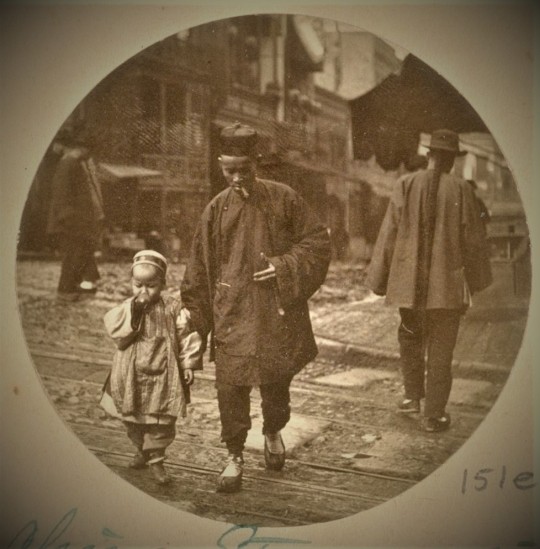
Cigar-smoking father and child crossing from what appears the northeast corner of Waverly Place and Clay Street, c. 1889. Photographer unknown (from the Jesse B. Cook collection at the Bancroft Library). In the background, the lanterns and façade of the Tin How temple appear on the west side of Waverly Place.
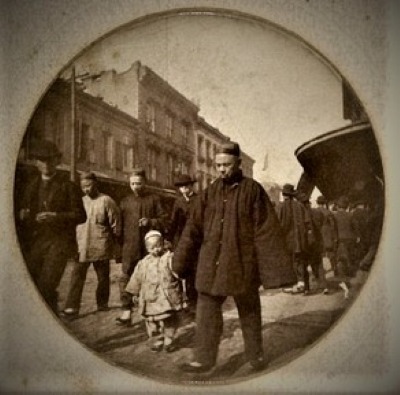
“Exterior View of Chinatown, San Francisco,” c. 1889. Father and child crossing a street. Photograph by Sam Cheney Partridge and printed by W.B. Tyler (from the collection of the Fine Arts Museums of San Francisco).

“Exterior View of Chinatown, San Francisco,” c. 1889. Father and child crossing a street, probably Dupont. Photograph by Sam Cheney Partridge and printed by W.B. Tyler (from the collection of the Fine Arts Museums of San Francisco).
Merchants in Chinatown carried the weight of responsibility on their shoulders. They built successful businesses, often establishing general stores, herb shops, or import-export enterprises. These fathers not only provided for their families' needs but also played a significant role in fostering economic stability within the community. They managed the intricate dynamics of trade, built networks, and navigated the challenges of language and cultural barriers. Through their entrepreneurial spirit, these fathers demonstrated perseverance, resourcefulness, and a commitment to creating a better future for their children.
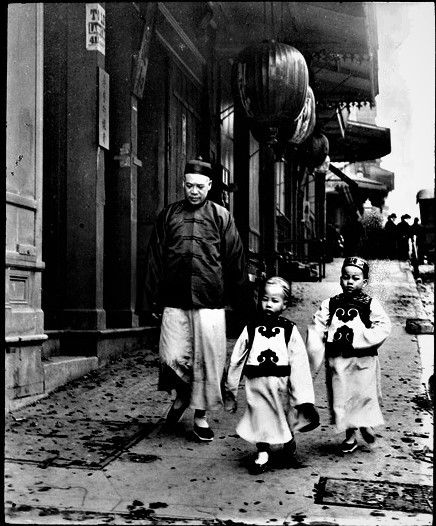
“Children of High Class” c. 1900. Photograph by Arnold Genthe (from the Genthe photograph collection, Library of Congress, Prints and Photographs Division). Merchant Lew Kan (a.k.a. Lee Kan) walking with his two sons, Lew Bing You (center) and Lew Bing Yuen (right). According to historian Jack Tchen, “Lew Kan was a labor manager of Chinese working in the Alaskan canneries. He also operated a store called Fook On Lung at 714 Sacramento Street between Kearney [sic] and Dupont. Mr. Lew was known for his great height, being over six feet tall, and his great wealth. The boys are wearing very formal clothing made of satin with a black velvet overlay. The double mushroom designs on the boys’ tunics are symbolic of the scepter of Buddha and long life.”

Father and child c. 1889. Photographer unknown (from the Jesse B. Cook collection at the Bancroft Library).
On the other hand, fathers working as laborers in Chinatown faced arduous working conditions and limited job opportunities. Many found employment in industries such as laundries, restaurants, or as laborers on the Central Pacific Railroad. These fathers toiled tirelessly to ensure their children had a better life than their own, often enduring long hours and physically demanding work. They displayed immense determination, resilience, and selflessness as they braved harsh conditions and discriminatory practices.

Young girls crossing the cable car tracks on Clay Street at the northeast corner of its intersection with Dupont under the watchful eye of their father, c. 1890. Photographer unknown (from the Marilyn Blaisdell collection).
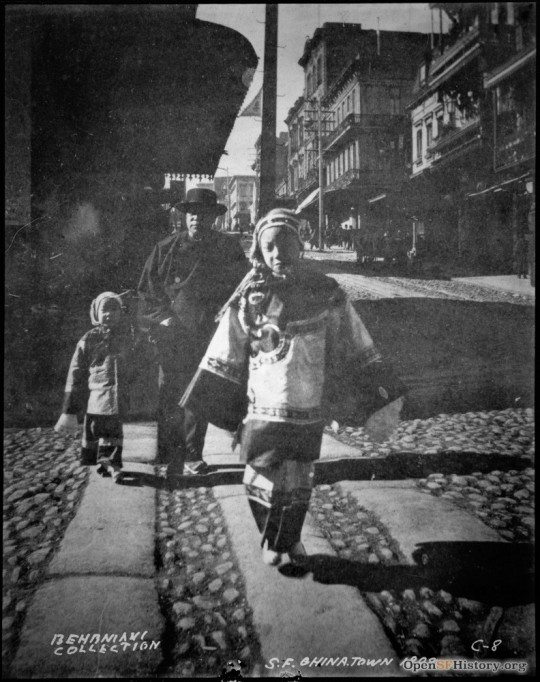
“S.F. Chinatown 1898.” Photographer unknown (from the Martin Behrmann Collection of the GGNRA). The daughters’ festive attire suggests that this image was taken during the Chinese New Year holidays. The incline of the hill, the appearance of the lanterns hanging from the double-balcony façade of the Yoot Hong Low restaurant at the right of the photo, and the cable car tracks in the background indicate that the trio were walking east on Clay Street and crossing Dupont Street from the southwestern to the southeastern corner of the intersection.
Regardless of their occupation, fathers in Chinatown shared a common goal: providing for their families and instilling values in their children. They recognized that education was the key to unlocking doors of opportunity and breaking free from the confines of poverty, if not segregation. Despite facing language barriers and limited resources, these fathers encouraged their children to pursue knowledge and acquire skills that would help them succeed in the ever-changing landscape of America.

Chinese American men and child in front of building with hanging lanterns, Chinatown, San Francisco, c. 1896 - 1906. Father and infant conferring with a smoking man on the sidewalk in front of a store. Photo by Arnold Genthe (from the Genthe photograph collection, Library of Congress, Prints and Photographs Division).
Fatherhood in old Chinatown was also a testament to the unwavering support and sacrifice made for the well-being of the family. Many fathers left their homes and families behind in China, enduring years of separation to seek better opportunities in the United States. Their commitment to their families was demonstrated through their remittances, which provided financial stability and, for a lucky few during the Exclusion era, allowed their loved ones to join them in the new world.

“A Holiday Visit” c. 1897. Photo by Arnold Genthe (from the Genthe photograph collection, Library of Congress, Prints and Photographs Division). According to historian Jack Tchen: “The baby is wearing Western shoes. The girl with the balloon is a member of the SooHoo family. She was one of three sisters and four brothers. She later married a Jung and had eight children. After the earthquake, her father was a carpenter for white families who needed skilled craftsmen to restore their houses.”

Father follows two children with another father and infant seen on the corner in the background, c. 1900. Photographer unknown (from a private collection). This image has been corrected from the opensfhistory.org website.

Father and child walking north on Dupont Street, c. 1900. Photographer unknown (from a private collection). The darker signage in the upper right reads: 仁安堂衛生鋈酒 (canto: “Yan On Tong wai saang yook jau”; lit. “Benevolent Peace hall hygienic liquor”).
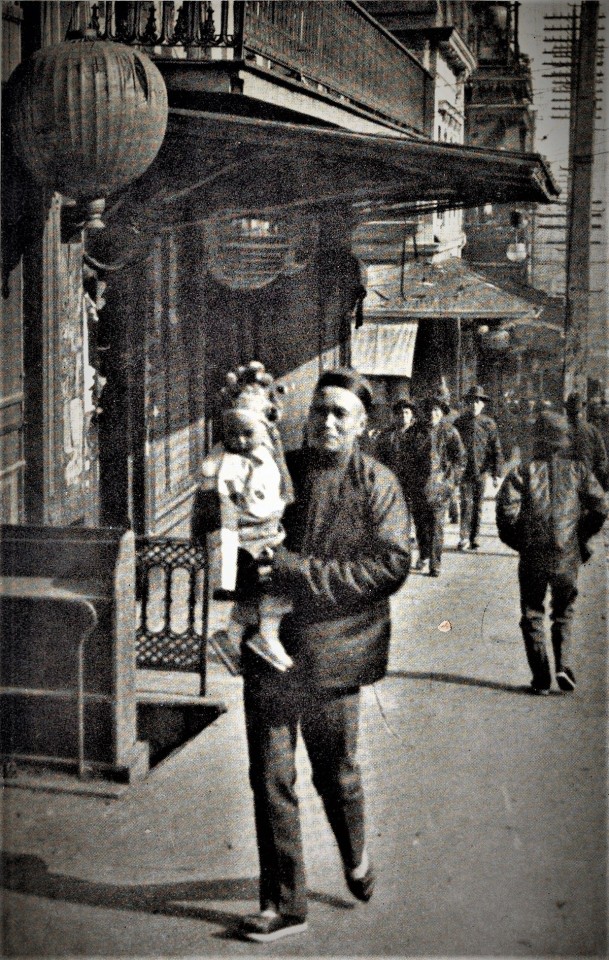
“New Year’s Day in Chinatown” c. 1900. Photograph by Arnold Genthe (from the Genthe photograph collection, Library of Congress, Prints and Photographs Division). “Nearly half of Genthe’s Chinatown photographs were taken during some community holiday,” historian Jack Tchen has written. “The merchant and child are walking westward up Clay Street just above Waverly Place. The lantern directly in line with the boy’s head is a sign for the Siyi [四邑; canto: “sei yap”], or Four Districts, Association located at 820 Clay Street.”

A father holds his child as he converses with two men whose faces are shadowed in front of a sidewalk stall. No date, photographer unknown (from a private collection).

“Paying New Year’s Calls” c. 1900. Photograph by Arnold Genthe (from the Genthe photograph collection, Library of Congress, Prints and Photographs Division). The two men and children appear to be walking south on Dupont Street and crossing to the southeastern corner of its intersection with Clay Street.
One can infer from the many photos that Arnold Genthe and other photographers took of fathers and holiday-garbed children that the photographers captured activities around the second day or “beginning” of Chinese New Year (開年; canto: “hoi nien”; pinyin: “kāinián”), including paying visits (or 拜年; canto: “bye nien”) to relatives for the renewal of family ties and to close friends for relationship-building.

“Scene in Chinatown San Francisco” c. 1900. Photographer unknown (from a private collection).

Photograph by Arnold Genthe (from the Genthe photograph collection, Library of Congress, Prints and Photographs Division). Historian Jack Tchen wrote about this image as follows: “. . . In [Genthe’s book] Old Chinatown this photo was entitled ‘He Belong Me.’ The bull’s-eye sign further down Washington Street indicates a shooting gallery. This block was only half Chinese.” The window signage seen in the immediate background shows W.D. Hobro, “Gas & Steam Fitting,” at 728 Washington Street, across from Portsmouth Square, ca. 1897. “Hobro ran a lucrative plumbing business serving the Chinatown area,” Tchen has written. “Chinese were not allowed into the plumbers’ union until the late 1950s.”
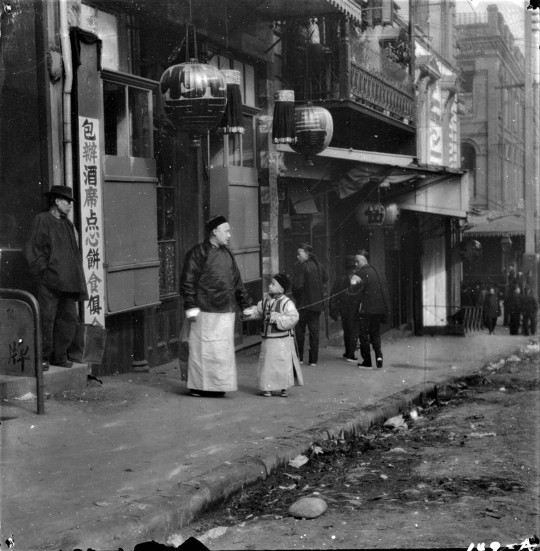
“A Family from the Consulate, Chinatown, San Francisco,” c. 1900-1906. Photograph by Arnold Genthe from the Genthe photograph collection, Library of Congress, Prints and Photographs Division. A father and son (with a balloon), attired as befitted a merchant family, walking west on the north side of Clay above Dupont Street. More modestly-dressed passersby stare at the pair, perhaps in recognition of the man’s status as a consular official. The long vertical signage parallel to the drainpipe in the left-hand part of the image has been damaged. Other photos from this period show the complete sign as 包辩酒席占点心餅食俱全 (canto: “bow bin jau jik tin dim sum behng sihk geuih chuen”) or 包��酒席 “= can host banquet;” 點心餅食 “= dim sum bakery;” 俱全 “ = both or complete.” The writing on the lanterns at the ground floor identifies a restaurant as 悦香酒樓 (canto: “Yuet Heung Low”). The shuttered storefront of the Yoot Hong Low restaurant’s premises at 810 Clay Street indicates that the building was closed for the New Year holiday.

A father walks with his family north on Ross Alley, no date. Photographer unknown (from a private collection).
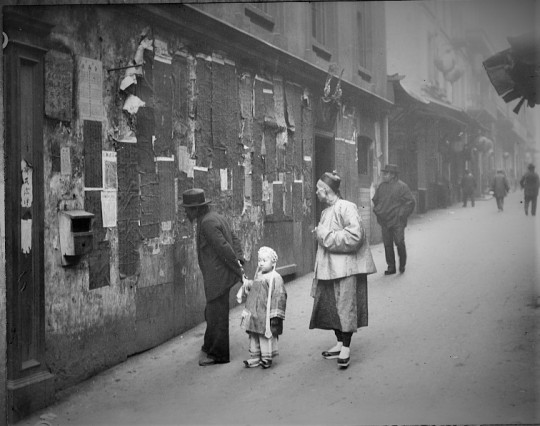
Ross Alley from Jackson Street, c. 1898. Photo by Arnold Genthe (from the Genthe photograph collection, Library of Congress, Prints and Photographs Division). Historian Jack Tchen: “The wooden box affixed to the wall on the left was for disposing of paper scraps. Genthe inaccurately entitled this photograph ‘Reading the Tong Proclamation.’ According to many guide pamphlets and books written during this time, these notices proclaimed who would be the next victim of tong ‘hatchet men.’ In actuality, they reported a variety of community news.”
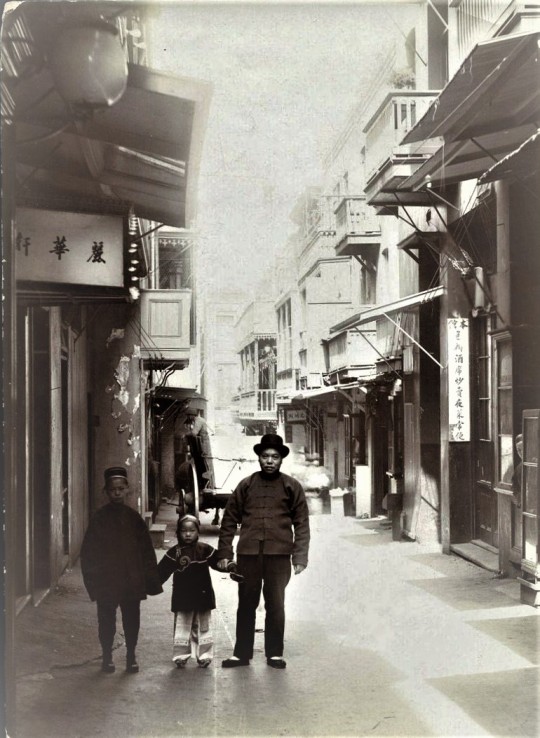
A Chinese merchant with his two children in Ross Alley of pre-1906 San Francisco Chinatown, c. 1902. Photograph attributed to Charles Weidner (from a private collection).

Chinese merchant and his children. Photographer possibly by Charles Weidner (from the Cooper Chow collection at the Chinese Historical Society of America). This image appears to be a continuation shot of the same trio of father, daughter and son Weidner took in Ross Alley. All three are wearing the same clothes and posing in front of what is probably the father’s business premises. Outside of his store, the merchant shows more of a smile as he looks directly at the camera lens, perhaps more familiar with the photographer. Even his son has started to show the beginning traces of a smile. This implies that the photographer either followed the trio from Ross Alley to the father’s place of business or encountered the merchant and his offspring for another photo. Prominent advertising signage appears above the doorway to the business which reads from right to left as follows: 廣珍號珍珠玉器金銀首飾男女新衣蘇杭發客 or roughly “Guangzhen Pearl Jade Gold and Silver Jewelry Men’s and Women’s New Clothes Suzhou and Hangzhou” (pinyin: “Guǎng zhēn hào zhēnzhū yùqì jīnyín shǒushì nánnǚ xīn yī sūhángfā kè “; canto: “Gwong Zun ho sunjiu yok hay gam ngan sau sik nam neuih sun yee so hong faat haak”). The barely discernible calligraphy on the upper-right pane of the store window frame bears the probable business name, 廣珍 (“Gwong Zun”). Magnification of the window reveals at several photographs that can be seen through the window. At least four framed photos are visible on a wall behind a desk. On the most discernible of the photos, a figure appears to be seated and holding a fan – a pose commonly used by Chinese subjects in the studio portraiture of the late 19th century. The figure could be an ancestor or even the merchant’s wife, as photos became essential evidence to overcome the hurdles to the effective denial of entry to the US by Chinese females after the enactment of the Page Act of 1875 which purported to bar the immigration of prostitutes. A couple of wooden shutters appear behind the merchant and his son. The panels would have been used to cover the window as a security measure. A similar set of shutters also appear at the far right of the photo frame, indicating the merchant shared this alleyway or street with other businesses. Unfortunately, the signage (appearing in the upper right-hand corner of the frame), for what appears to be a street number or street name is illegible.
The fathers of old San Francisco Chinatown were unsung heroes who forged a path for future generations. Whether as successful merchants or hardworking laborers, their contributions to their families and community were immeasurable. Their legacy is deeply ingrained in the history and fabric of modern-day Chinatown and the mythology of Chinese America itself, where their sacrifices and contributions are remembered and celebrated.
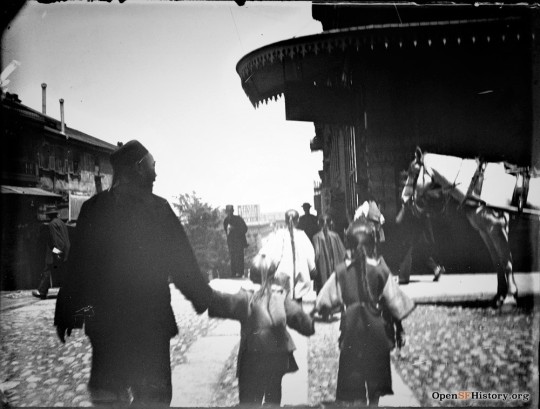
A father escorts his two children across Dupont Street, heading west down the hill on the south side of Clay Street, c. 1886. Photographer unknown (from a private collection). The trees of Portsmouth Square park can be seen in the distance.
Today, the descendants of these fathers continue to honor their heritage, proudly embracing their Chinese American identity while embodying the resilience and determination that their fathers instilled in them.
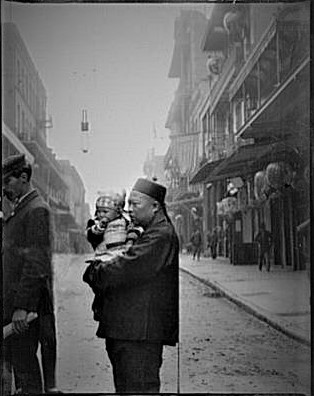
“A Proud Father” c. 1900-1905. Photo by Arnold Genthe (from the Genthe photograph collection, Library of Congress, Prints and Photographs Division). A father and child are seen crossing Dupont Street at its intersection with Clay Street from the northeastern to northwestern corner. The lanterns and balconies of the Wauy Sin Low restaurant at 808 Dupont can be seen in the background at right. According to historian Jack Tchen, “[a] man’s elbow has been etched out of the photograph. The object hanging above the street is an electric street light attached to a pulley. When the bulb burned out, the light would be pulled over to the side of the street and changed.”

“Man and boy walking on street” c. 1900-1905. Photo by Arnold Genthe (from the Genthe photograph collection, Library of Congress, Prints and Photographs Division). Based on his dress, the man appears to be a merchant. The boy’s festive dress indicates that the photo was taken during a holiday.

“Man and children walking down a street,” c. 1900-1905. Photo by Arnold Genthe (from the Genthe photograph collection, Library of Congress, Prints and Photographs Division).
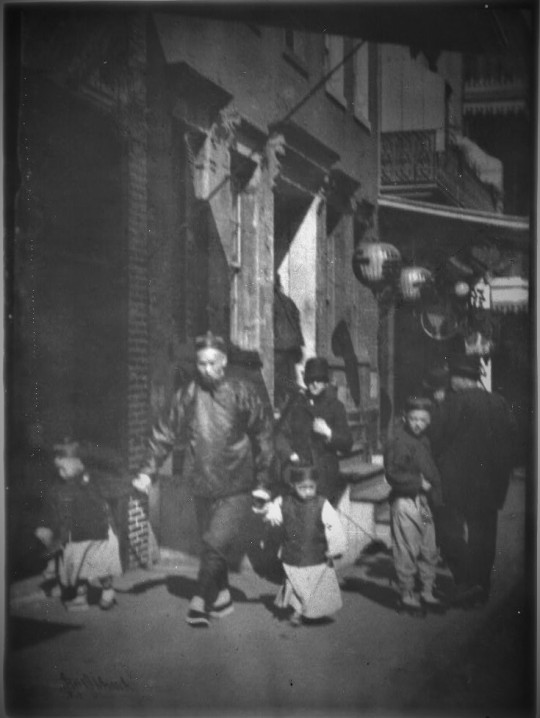
“Man and two boys walking along a street,” c. 1900-1905. Photo by Arnold Genthe (from the Genthe photograph collection, Library of Congress, Prints and Photographs Division). Based on his dress, the man appears to be a merchant. The boy’s festive dress indicates that the photo was taken during a holiday.

“Man and two children crossing a street,” c. 1900-1905. Photo by Arnold Genthe (from the Genthe photograph collection, Library of Congress, Prints and Photographs Division).

“Man and a young child walking,” c. 1900-1905. Photo by Arnold Genthe (from the Genthe photograph collection, Library of Congress, Prints and Photographs Division).

“Man carrying a child accompanied by another child,” “Man and two children crossing a street,” c. 1900-1905. Photo by Arnold Genthe (from the Genthe photograph collection, Library of Congress, Prints and Photographs Division).
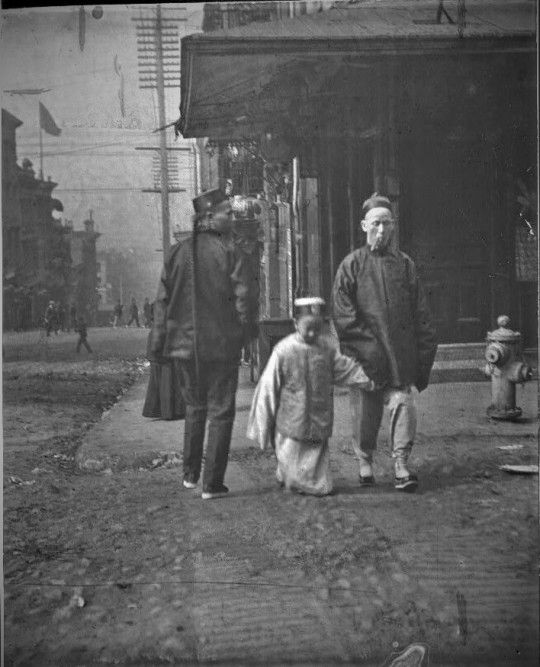
“Boy and a man smoking a cigar crossing a street,” “Man and two children crossing a street,” c. 1900-1905. Photo by Arnold Genthe (from the Genthe photograph collection, Library of Congress, Prints and Photographs Division).

“Waiting for the Car” c. 1904. Photo by Arnold Genthe (from the Genthe photograph collection, Library of Congress, Prints and Photographs Division). Historian Jack Tchen writes about this photo as follows: “The Sue family at a Dupont Street corner. Mrs. Sue is shown with her eldest daughter, Alice, with Elsie sandwiched between them. Her brother-in-law is holding Harris. Alice is wearing strings of pearls and semiprecious stones on her head dress. Mrs. Sue is wearing a black silk-on-silk embroidered outfit. Married women generally wore dark, subdued clothing that distinguished them from prostitutes. Elsie and Harris are wearing leather shoes; however, Alice and her mother wear Chinese-style footwear. Mr. Sue, who died after the 1906 earthquake, ran a doc sic guun, or “boarding house,” which fed male workers at nine in the morning and four in the afternoon, while Mrs. Sue took in sewing. (Information provided by Alice Sue Fun.)”
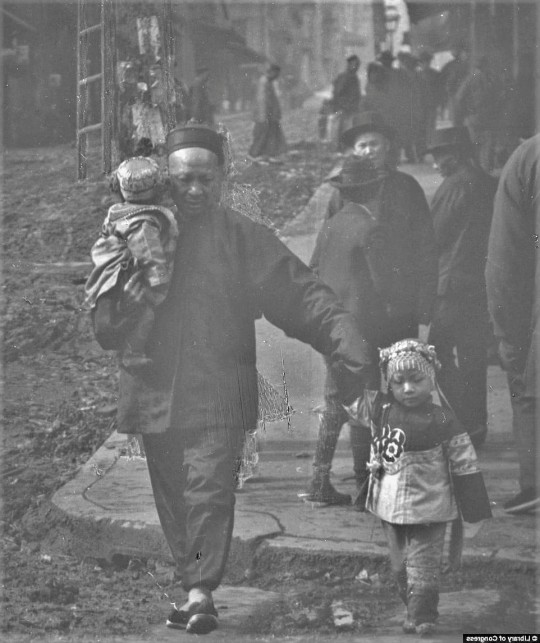
Father and two children walking downhill (probably Sacramento Street), c. 1904. Photo by Arnold Genthe (from the Genthe photograph collection, Library of Congress, Prints and Photographs Division). The girl’s festive dress indicates that the photograph was taken during the New Year holidays.

A sidewalk store proprietor/operator with his children, c. pre-1906. Postcard variant of a lithograph (from the collection of the Society of California Pioneers). Other card variants bear the caption “Chin Kee and family, Chinese Street Merchant, Dupont and Washington Sts. Chinatown, San Francisco” such as the card by Britton & Rey, Lithographers, San Francisco 515 (from the private collection of Wong Yuen-ming). To read more about the sidewalk stalls of old San Francisco Chinatown, go here.

“Dressed for a Visit” c. 1896 - 1906. Photograph by Arnold Genthe (from the Genthe photograph collection, Library of Congress, Prints and Photographs Division). Historian Jack Tchen: “This photograph happens to capture the sign for the ‘Chinese Newspaper/War Kee’ at 803 Washington Street, just west of Dupont Street. The War Kee was founded in 1875. Although the names J. Hoffman and Chock Wong appear as the publishers of the first issue, a Yee Jenn has been cited as the founder. The War Kee, which was the first successful Chinese weekly published in Tangrenbu, folded in 1903. [Note: The Langley directory for 1876 contains a listing in its newspapers section for "Oriental (Chinese) Chock Wong & J. Hoffmann, 817 Washington." This address would have placed its first offices on the south side of Washington Street across from the southern entrance to Ross Alley.]
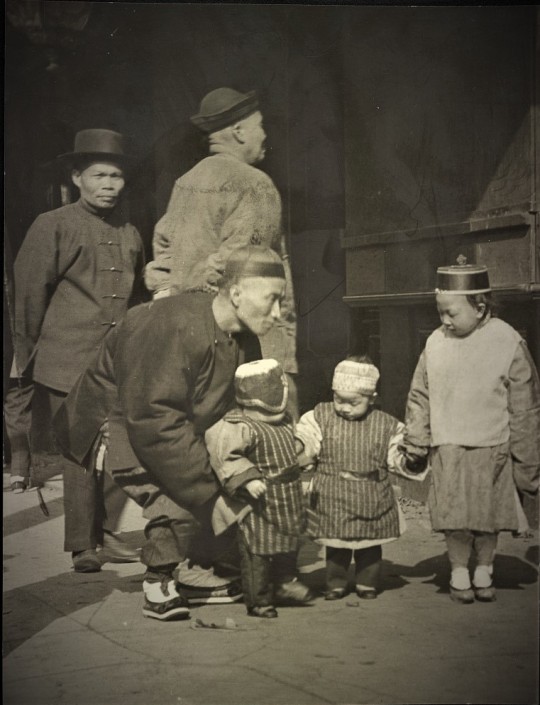
Chinese American men and three children in traditional dress standing on a street in Chinatown, San Francisco, c. 1896 - 1906. Photograph by Arnold Genthe (from the Genthe photograph collection, Library of Congress, Prints and Photographs Division).

“The Proud Father” c. 1905. Photo by Mervyn D. Silberstein (from a private collection). Silberstein specialized in photography of San Francisco Chinatown residents and producing hand-colored reproductions in “actual Chinese color combinations.” Silberstein’s own ads for his “Chinee-Graphs” promoted “[m]ost of these pictures were taken during the Chinese New Year festivities many years ago when the ancient customs were adhered to.”
[updated 2023-6-30]
#Chinese fathers of old San Francisco Chinatown#Lew Kan#Ross Alley#Dupont Street#Arnold Genthe#Sam Cheney Partridge#Chin Kee and family#Jack Tchen#Wauy Sin Low restaurant#A.J. McDonald#Charles Weidner
3 notes
·
View notes
Text

Buddha wall. Washington, DC.
May 2024.
#yzshot#travel#street photography#street#america#Washington#dc#washington dc#district of columbia#dupont circle#buddha#mural#graffiti#street art#graffiti art
9 notes
·
View notes
Text
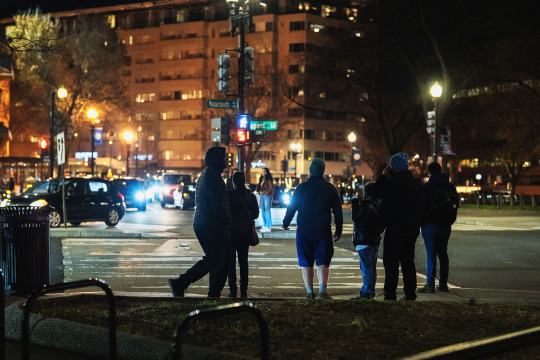
8 notes
·
View notes
Text

Dupont des Loges street in Paris
French vintage postcard
#carte postale#old#ansichtskarte#dupont#photo#vintage#postkaart#photography#briefkaart#postkarte#french#ephemera#postcard#sepia#street#postal#paris#tarjeta#loges#historic#des#dupont des loges
14 notes
·
View notes
Text
I actually never read Nimona which is weird and I canceled Netflix a few months back so anyway I'm going on an informal tour of bookstores in my area, which might be very short or might take me quite some time and then I'm going to read all day.
#unfortunately the weather is typically summer garbage but i persevere#anyway hot take kramer in DuPont is overcrowded and overrated but i need to go back to the place on h street#solid state. that place was nice.
11 notes
·
View notes
Note
hi, milla! i don't remember exactly how i worded the request that got ate so here's another idea i have instead! mwah, love youuuuu 🫶🏻
how about a songboard for reidaway + the concept of a night out on the town? all dressed up and fancy, trying the new italian restaurant down the street, that kind of vibe?
congratulations again on your milestone, love!! 🧡✨️
Thank you so much 💖😘💖😘


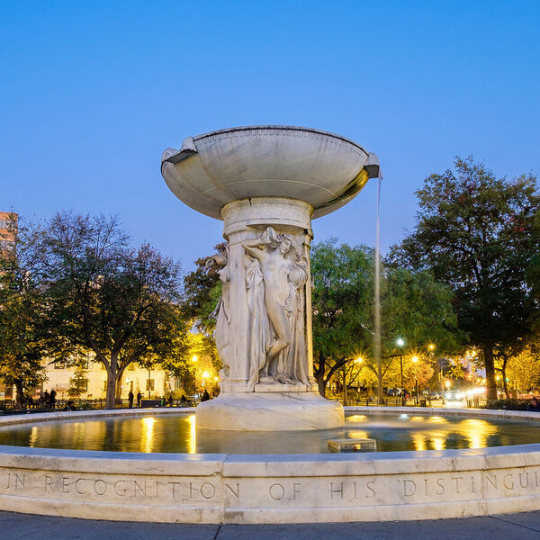
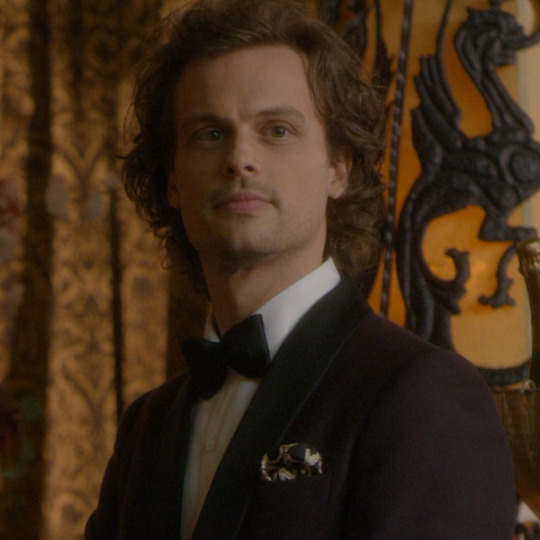





Reidaway + Bumpin' The Night (Florida Georgia Line) The night is young, the night is free and so are we So let it out and let me step inside your dreams
»»»— read pinned post for taglist info —«««
»— Masterlists links in bio —«
#asks#answered asks#reidaway criminalminds#spencelle criminalminds#reidaway criminal minds#spencelle criminal minds#reidaway cm#spencelle cm#reidaway songboard#spencelle songboard#spencer reid#elle greenaway#spencer reid criminalminds#elle greenaway criminalminds#criminal minds songboard#criminalminds songboard#cm songboard#criminalmindsedit#cm edit#criminal minds edit#songboard#millasafternoontea#milla's cm songboard#carmine's italian restaurant - washington dc#dupont circle fountain - washington dc#us capitol building - washington dc#pearl street - washington dc
7 notes
·
View notes
Text
“Morning always seems too stale to justify
Lament blossoms, hours, minutes of our lives
Broken thoughts run through your empty mind
At least a beaten dog knows how to lie”
Sleepflower - Manic Street Preachers
youtube
“The world will not be changed by millions of people voting for change, or demonstrating for change, because capitalist power is not constituted with reference to human feelings: political desires and demonstrations, which are the social forms consciousness takes, cannot touch capitalist domination but are merely determined by it. We have no place for consciousness in our scheme, we see no need for a generalised formulated desire for revolution. Revolution belongs to the mute body and its resistance to, and its giving out to, the imposition of work. What is needed in the revolutionary struggle is precedence given to the needs of the body (consumer culture is a contemporary echo of this. The slogans are not inspiring or romantic: more rest, more pay, less work, no deals on productivity. However, once this demand-regime is set in motion it cannot be side-tracked except by counterfeit political demands, or formulations of radical consciousness made by those who seek to lead it. Once the body tends toward rest, it cannot rid itself of that inclination unless it is roused again to work for some political vision. In short the struggle of industrial workers against capital will be conducted entirely in selfish terms, which in the end describes itself as the struggle against work in the interest of highly paid sleep. In the present nothing has significance but the desire to extend half-hour lunch breaks into hour lunch breaks. If all pro-revolutionaries grasp this they will stop worrying about the precondition of consciousness. It is within the political-economic figure of the imposition of work and its negation (which is comfort), that pro-revolutionaries could make a contribution to their workplace struggles. The struggle is against the maximisation of productivity and for the maximisation of rest. If workers could win their struggle in these terms then they will have broken up the basic mechanism of the capitalist system.
The struggle of the body for rest is not the revolution, it is merely the crisis of capital. A crisis because it brings the massed, accumulated, fossilised acts of the past and the sedimenting/accumulating dead acts of the present, along with the possible conditions for the future, together in collision and in this standstill all value ceases to be enforced, leaving the world in a kind of zero hour/zero place where everything is contestable. (When the traffic stopped last September during the Fuel Protests, a man on a bicycle passed me and said, "I can hear the birds singing." We have heard what economic collapse sounds like.) When industry stops everything in society, otherwise absolutely determined by it, floats free from its gravity. In this particular crisis of capital all hell breaks loose; then comes the time for organisation. You can call that consciousness if you want, we don't care.” - Monsieur Dupont, ‘Nihilist Communism: A Critique of Optimism in the Far Left’ (2009) [p. 26 - 27]
#dupont#monsieur dupont#nihilist#communism#manic street preachers#sleepflower#gold against the soul#sleep#worker#revolution#consciousness
3 notes
·
View notes
Photo

Dupont & Landsdown - Toronto April 2023. New Condos Galaria Mall. Photo BABAK
2 notes
·
View notes
Text
so unfair that Skip is forced to be an apartment dog 😕 get that boy a yard and a pond
#boy can't even go on walks own I street or around Dupont Ciricle#hawk go buy him a house now-#pup skip#hawk x tim#buck brawls
0 notes
Text
reincarnation
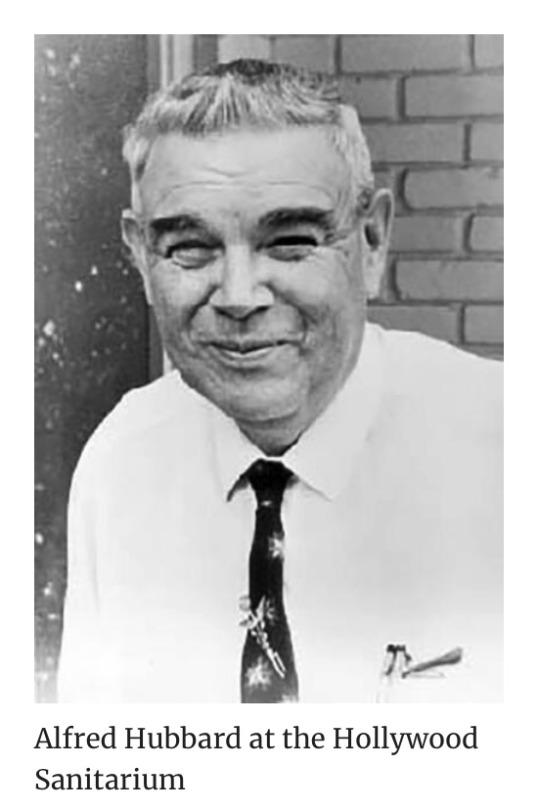

I always believed in reincarnation before I even really knew what it meant. At age 7, as a form of punishment from a babysitter sick of dealing with a bunch of nasty kids, she sent us all to “Vacation Bible Camp” which was literally like Bible School at the local Church and church related activities all week as some sort of an attempt to teach us to stop being so mean to each other. My sister was getting bullied by other kids there, and it was the Christian Missionary babysitter’s way of staging an intervention of sorts in the only way she knew how. I was raised without religion other than my grandparents giving me a kids version of the bible, my parents attempting to drag me to church on Christmas once so I could see how other folks celebrated, and then this vacation bible camp. At the end of the week we were told to “go into the chapel and pray to god” and silly little me—— I was like “hey God, when I die, I wanna be reincarnated as a cat in my next lifetime!” Because I LOVED cats and one of my favourite things to do was going over to my friend’s family farm and spending time with the countless barn cats and their kittens. even before I even knew what would entail, like the fact that I would have to karmically fuck up perhaps to have a lower birth order in my soul’s next lifetime? Or would that mean that cats are the gods the Egytians worshipped them as? And that they should be treated as such by society? Hmm interesting way of looking at it two ways? I tell my cat that he is my Angel all the time?
anyways back on topic to the two photos. The first photo on the left is Al Hubbard, and the second photo on the right is Lahiri Mahasaya. Al, who was one of the first people using and distributing acid in this neighborhood, with the headquarters of his operations running out of an old brothel on Alexander Street. I was learning about the history of the first red light district in Vancouver, the first brothels, and how sex workers were pushed from block to block by the city and the cops. So first, back in the original township of granville aka gastown there’s already like 3ish brothels or “houses of ill repute” known. Then DuPont Street aka East Pender between columbia and carrall and later expanded up to main and down to abbott in general area. A bunch of brothels were built but mostly were single rooms with one worker occupying them. Then the workers got pushed up to Shore Street aka east Georgia street west of Main Street towards false creek, then they got pushed to Alexander street where many of the privileged and prosperous madams had lavish brothel buildings built rather quickly and luxuriously by the standards of the time. There were a LOT of brothels in the area as well as a LOT of workers and this was the original red light district of Vancouver. Chinatown literally used to have red lights? Anyways back to Al- he was referred to as Captain Trips and was known to carry a bunch of acid that he would hand out “to the right people” in hopes that it would help them wake up and perhaps experience a glimpse of what a religious experience or what enlightenment could possibly be like. He just handed out acid like money didn’t matter and died broke because it was all about the spirituality and the potential for positive change that LSD held. He ended up moving his business into one of these old brothels at Jackson and Alexander. I actually hung out there once about ten years ago. But when I saw his photo for the first time, I was shocked when I noticed the similarities between his face and Lahiri Mahasaya, one of my beloved teachers from a different time period, who as a yogaavatar, has transcended time and space to come visit me. If y’all have read Autobiography of a Yogi - you know I’m not joking about this being possible. Their eyes. Their eyes convey an eerie similar blissed expression. I would not be surprised if Al Hubbard was a reincarnation of Lahiri Mahasaya, I mean that would likely explain a lot of similarities between the two from what I’ve learned. Super trippy. Pretty sure different past life versions of my soul have spent time with both of them. anyone that knows me knows I talk about past lives a lot but I just learned my name from a recent past life and I’m fucking thrilled with how much I have discovered about that lifetime, it’s like the greatest, most compelling mystery of my ancestral trauma that I am so relentlessly seeking answers to and now they just flow to me 💕 it’s the greatest healing gift to my soul.
#Past lives#ancestral trauma#ancestral healing#intergenerational trauma#History#Reincarnation#Lahiri Mahasaya#Al Hubbard#Acid Al#LSD#Vancouver’s first red light districts#sex work history#sex work in Vancouver#brothels#Alexander street#DuPont Street
0 notes
Text
Daffodils of Dupont #toronto #wallaceemerson #dupontstreet #garden #spring #flowers #daffodils #yellow

3 notes
·
View notes
Text

“Jewish Balloon Man” c. 1896 – 1906. Photograph by Arnold Genthe (from the collection of the Library of Congress Prints and Photographs Division). Two Chinese men and a child inspect the offerings from a balloon seller at the northwest corner of the intersection of Dupont and Jackson streets, just outside the Globe Hotel.
Balloon Men of Old Chinatown
In the 21st century, online research is more likely to produce a plethora of entries about a Chinese spy balloon rather than the balloon sellers of pre-1906 Chinatown. Nevertheless, the photographic images of the non-Chinese balloon and toy vendors remain worthy of examination and consideration.
Toy balloon vendors plying their wares in old Chinatown, in addition to the storefronts of non-Chinese owned or operated businesses, provided a modest counter-narrative to the perception that the neighborhood represented an entirely foreign enclave. Historian Jack Tchen has written that "[s]everal white novelty peddlers on Dupont Street sold to tourists visiting Chinatown and the Barbary Coast. In contrast to the the often antagonistic relations between the Chinese and the irish and Italians, little conflict occurred between Jews and Chinese. Reportedly, two German Jewish brothers, known as the 'Sa Ling Brothers,' ran a store on Dupont Street and even spoke fluent Cantonese."
Even a notorious exoticist as Arnold Genthe, who went to great lengths to crop or scratch out non-Chinese figures and businesses from his photos of old Chinatown, could not resist taking his own photographs of balloon sellers catering to the whimsy of the 1,000 to 2,0000 children who lived in old Chinatown by the turn of the 20th century.

Buying Balloons or “The balloon man” c. 1897. Photograph by Arnold Genthe (from the collections of the California Historical Society and the Library of Congress Prints and Photographs Division). In this wider angle shot, a balloon seller working in Chinatown shows his wares to two boys and four girls. Based on the children’s attire (especially the headdresses worn by the girls), the photo was probably taken around the New Year holidays when children were seen walking freely around the neighborhood.

“The Balloon Man” c. 1897. Photograph by Arnold Genthe (from the collections of the California Historical Society and the Library of Congress Prints and Photographs Division).
The California Historical Society’s Director of Exhibitions, Erin Garcia, wrote about CHS’ copy of Genthe’s published print of his photo, The Balloon Man, as follows:
“In The Balloon Man, one of many photographs by Arnold Genthe (1869–1942) in the California Historical Society’s collection, we find ourselves transported to San Francisco’s Chinatown at the dawn of the twentieth century on a holiday. Children dressed in finery and group of men gather on a street corner around a balloon seller. Floating near their heads are three shiny orbs, rendered with a metallic luster on the gelatin silver photographic paper. The image is strangely dark and moody despite the festive subject matter and this piques my interest. The children should be delighted, but we cannot see their faces. The somber tone continues throughout the composition with the children surrounded by a mass of men in dark clothing. The balloon vendor is so darkly printed in his black coat and hat that he is practically indistinguishable from the background. All we see of his bouquet of balloons are the two attached to his stick; the rest hover above, beyond the frame of the photograph. We are not permitted to see the spectacle nor the reaction of those watching it. Instead Genthe wants us to focus on the children, in their bright clothing, like lights shining amid an indistinct darkness."

A child and a balloon man, c. 1889. Photographer unknown (taken in the manner of Sam Cheney Partridge?) from the Jesse B. Cook collection at The Bancroft Library. A third identifiable balloon seller working in Chinatown shows his wares to a boy

The Balloon Man” c. 1896 – 1906. Photograph by Arnold Genthe (from the collection of the Library of Congress Prints and Photographs Division). Genthe's close-up print of a wider angle image. Two Chinese men and a child inspect the offerings from a balloon seller at the northwest corner of the intersection of Dupont and Jackson streets, just outside the Globe Hotel. The residential hotel would gain notoriety as the location where the first case of bubonic plague would be diagnosed in 1900.
One can only speculate how language barriers and cultural differences might have made communication more difficult, but the wonder of a rubber balloon to a child probably transcended such barriers for the sale.

Two girls and a boy speak with a balloon seller, no date. Photographer unknown (from a private collection). The façade seen in the background in the left was probably the entrance and second floor balcony of the Yoot Hong Low restaurant at 810 Clay Street. The vague outline of cable car tracks appears on the cobblestone street seen behind the girl at left.

“Two Girls with Balloons” c. 1900. Photograph by Arnold Genthe (from the collection of the Library of Congress Prints and Photographs Division). The girls seen bringing home their balloons are probably attired for, and during, the Chinese New Year holiday. The older girl is wearing Qing-era platform shoes intended to emulate the walking style of a bound-foot woman.

“The Toy-Balloon Man” c. 1896. Illustration by Theodore Wores for his magazine article, “Children of Chinatown in San Francisco.”
Artist Theodore Wores wrote for the magazine St. Nicholas, vol. 23, no. 7 (May 1896) about New Year’s time and balloons as follows:
“About the time of the Chinese New Year Chinese children are particularly favored, and the fond fathers deny them nothing. The little ones always appear to be well provided with pocket-money to buy toys and candies. “As a result, not only the Chinese shopkeepers, but peddlers of other races, reap a rich harvest about this time by selling toys and novelties. The seller of toy-balloons seems very popular, and is surrounded by boys and girls eager to buy the fascinating rubber globes.”

A detail from the photo “Returning Home” c. 1896-1906. Photograph by Arnold Genthe (from the collection of the Library of Congress Prints and Photographs Division). The father and daughter holding a balloon are walking west up the hill on the 800-block of Clay Street.
After the devastating 1906 earthquake and subsequent reconstruction of San Francisco's Chinatown, balloon sellers made a pleasant return to the streets, perhaps symbolizing resilience and continuity. Their reappearance undoubtedly conveyed a sense of familiarity and nostalgia, reminding the returned families of joyous moments, past and those to come, on the streets of old Chinatown.

A mother and four children examine the wares of a balloon and toy peddler at a corner of Grant Avenue, c. 1910. Photographer unknown (from a private collection).
The presence of non-Chinese balloon sellers in pre-1906 San Francisco Chinatown added an extra layer of diversity and charm to the community. Their presence represented the intermingling of cultures, fostering a sense of curiosity and wonder among residents and visitors alike. Thanks to the pioneer photographers of the old neighborhood, balloon sellers became part of the vibrant visual tapestry of old Chinatown, offering to a new generation perhaps a glimpse of the broader world beyond Chinatown's segregated borders and introducing a new form of entertainment.

“Balloon Man of Chinatown San Francisco 1904.” Oil painting by Mian Situ. Arnold Genthe's "Jewish Balloon Man" photo taken at the northwest corner of Dupont and Jackson streets (including the architectural detail of the old Globe Hotel at the top-center of the image), served as the inspiration for this work by modern artist Situ.
#Balloon Men of old Chinatown#Arnold Genthe#Theodore Wores#Globe Hotel#Mian Situ#Yoot Hong Low restaurant#Jackson and Dupont streets#Clay Street old Chinatown#Jewish novelty peddlers of old Chinatown
4 notes
·
View notes
Text
A Big Move
No, not me: the Crowninshield-Bentley House! Visiting Louise DuPont Crowninshield’s former garden in Marblehead last week prompted me to reconsider her impact on Salem as a preservation advocate and philanthropist as it is considerable. At least two institutions in Salem, the Salem Maritime National Historic Site and the Peabody Essex Museum, reflect her commitment to the preservation of Salem’s…
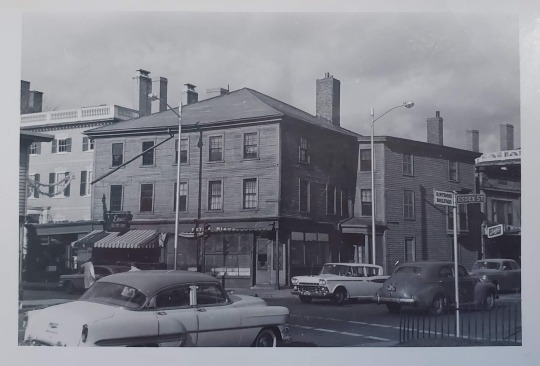
View On WordPress
#Essex Institute/ Peabody Essex Museum#Essex Street#great houses#Historic Interiors#Historic Preservation#Louise DuPont Crowninshield#Moving Houses#periodicals#Phillips Library#Photography#The Reverend William Bentley
0 notes
Text
it all fell down (ln4)
part1
multipart story! next
✦ pairing - lando norris x female reader
summary : lando norris and y/n were friends for 20 years, fell in love and dated for five. until it all fell down. they left each others lives abruptly and never spoke again, until they met again in the most unexpected way. can they find their way back or will certain scars never heal?

The bustling streets of Monaco were as busy as ever, a stark contrast to the calm that Y/N felt inside. The rhythmic tapping of her heels on the marble floor echoed through the sleek office building. She had always loved the city, but now it represented something more than just beautiful scenery; it was her sanctuary, her fresh start.
"Morning, Y/N," greeted Claire, her assistant, as she handed Y/N her daily latte.
"Morning, Claire. Any updates for today's schedule?" Y/N asked, taking a sip of the coffee, savoring the familiarity of the taste.
"Just the usual. The meeting with the investors is at 10 AM, and you have a lunch appointment with Mr. Dupont at 1 PM," Claire replied, handing over a neatly organized file.
"Perfect. Let's make sure everything is set for the presentation," Y/N said, her voice steady and professional.
As the CEO of her own thriving marketing firm, Y/N had built a reputation for herself. She was known for her sharp mind, impeccable work ethic, and the ability to turn even the most mundane products into must-haves. Her company, InspireVision, had taken the European market by storm, landing high-profile clients and creating groundbreaking campaigns.
But behind the polished exterior and the confident demeanor lay a heart that had been shattered two years ago. The memories of Lando were locked away in a corner of her mind she seldom visited. The laughter they shared, the dreams they built together, the love that once felt unbreakable—all of it was a distant echo now. They had both moved on, or so she told herself.
sneak peek into lando's life
The sound of engines roaring filled the air as Lando Norris stepped out of his sleek, black McLaren. The circuit was alive with energy, mechanics bustling around, and the smell of burning rubber in the air. For Lando, this was home.
"Hey, Lando! Ready for practice?" called out Carlos Sainz, his teammate and close friend.
"Always, mate," Lando replied with a grin, adjusting his racing suit. "Let's show them what we've got."
The past two years had seen Lando rise to new heights in his racing career. He had secured multiple podium finishes and even a race wins. The world saw him as a fierce competitor, a young talent with a bright future. But beneath the helmet and the bravado, there was a part of him that still ached.
"Hey, Lando, I was thinking about grabbing dinner at that new place by the marina. You in?" Carlos asked as they headed towards the garage.
"Sure, sounds good. Need to unwind a bit," Lando replied, though his mind was only half on the conversation.
Racing was his escape, his way of pushing away the thoughts of what could have been. The nights were the hardest, when the adrenaline faded and the silence crept in. It was then that memories of Y/N surfaced—her smile, her touch, the way she used to laugh at his jokes. They had shared twenty years of friendship and five years of love, only to part ways abruptly. They had never spoken again, both too proud and too hurt to reach out.
back to y/n
Y/N's day was a whirlwind of meetings and phone calls. By the time she sat down for lunch with Mr. Dupont, she was mentally exhausted but maintained her poised demeanor.
"It's impressive what you've done with InspireVision, Y/N," Mr. Dupont said, raising his glass in a toast.
"Thank you, Mr. Dupont. It’s been a journey, but I have a great team behind me," Y/N replied, clinking her glass with his.
As they discussed potential collaborations, her phone buzzed with a notification. She glanced at it briefly—an update on the Monaco Grand Prix. She quickly dismissed it, burying any thoughts of the racing world and its connection to her past.
and here is lando again
The practice session went well, and Lando felt a familiar rush of excitement. After a quick debrief with his team, he headed out with Carlos for dinner.
As they walked along the marina, the city's lights reflecting off the water, Lando felt a rare moment of peace.
"You ever think about what's next, beyond racing?" Carlos asked, breaking the comfortable silence.
"Sometimes. It's hard to imagine life without it, though," Lando admitted.
"Yeah, I get that. But there's more to life than just racing, you know?" Carlos said, giving Lando a knowing look.
Lando nodded, understanding the unspoken words. There was more to life, but it was a life he had once envisioned with Y/N. Now, it was a blank canvas, waiting for new memories to be painted on it.
The two former lovers, now strangers to each other's lives, were both thriving in their own worlds. They had built walls around their hearts, focusing on their careers and new dreams. Yet, the echoes of their shared past lingered in the background, a silent reminder of the love that once was. Neither spoke of the other, living as though the other didn't exist. But fate had a way of bringing people back together, sometimes in the most unexpected ways.

taglist ---> @misspygmypie @kol67-t @sltwins @f1fantasys
comment to get added to taglist
#lando norris#lando norris x female reader#lando norris x you#lando norris x oc#lando norris x y/n#lando norris x reader#ln4#ln4 x y/n#ln4 x reader#ln4 x you#ln4 x female reader#formula 1 x female reader#formula 1 x y/n#formula 1 x you#formula 1 x reader#formula 1#f1 imagine#formula one#y/n#mclaren#f1 fics#f1 x female reader#f1 x y/n#f1 x you
406 notes
·
View notes